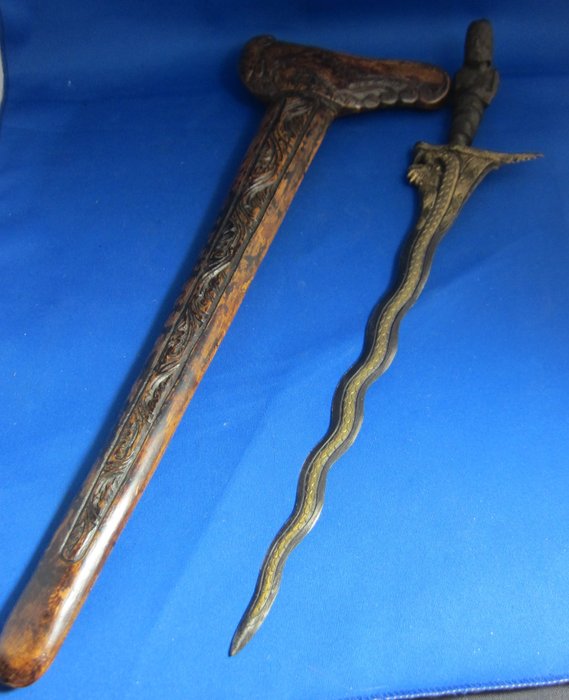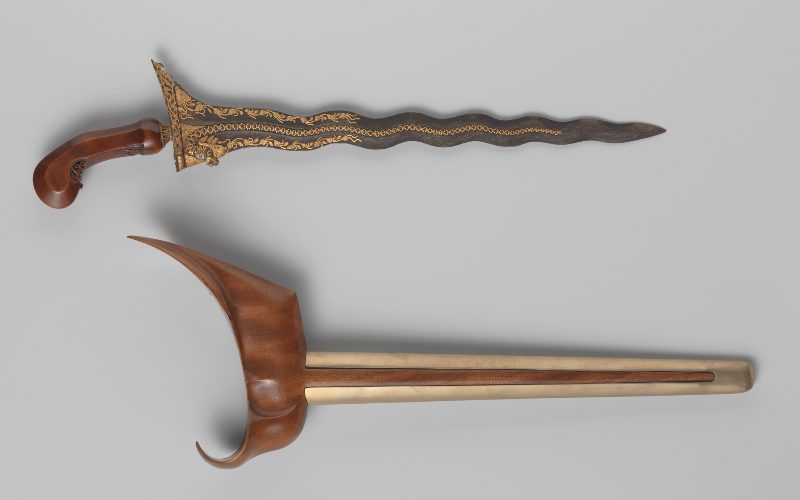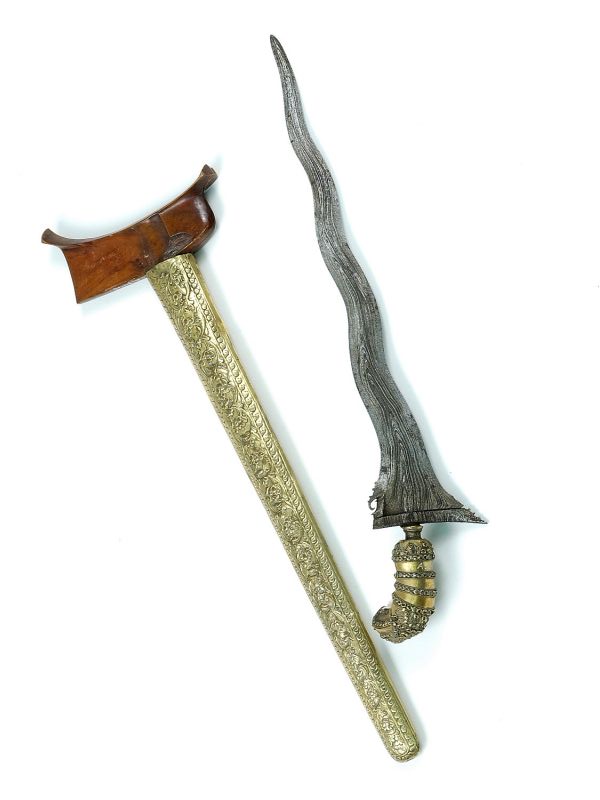Der Orientale 666
Active member
- Joined
- May 9, 2023
- Messages
- 172
The Kris (literally pronounced "Chris") is one of the most famous daggers of Maritime Southeast Asia and is an excellent to use for your rituals - since the kris' history is pretty-much rooted in occultic Vedism. Its handle was intentionally made for it be used as a wand, rather than a tool of battle. From Indonesia, to Malaysia, Thailand, Singapore, Brunei and the Philippines, it can be seen being wielded by the various elites. It is in many essences, quite equivalent to the katana in its importance, but its usage is obviously different.
You'll see in the picture that the center of the blade is brighter than the background often, and I'll get to that, it is of Satanic design.

Sadly, the athame is now hijacked by Muslims, and is associated with Muslim culture, however - this particular dagger has Vedic origins. You'll see this dagger on Muslim flags everywhere in Southeast Asia. In a Catholic country like the Philippines where a Muslim-Catholic divide exists, the site of a kris is going to scare the nuts of the average Filipino since they'll think your a terrorist. In Malaysia and Indonesia, they are considered symbols of power and authority.
Some examples of Muslim flags and coats of arms in Southeast Asia you'll see:



However the Truth is, the kris originated from the Majapahit Empire, and eventually is known to have origins back to Ancient India. Vedic, Hindu and Buddhist stone reliefs and carvings prove otherwise that the kris has long been in use for spiritual uses prior to Islam such as these found in Southeast Asia.




The details are a bit hard to see, in the 2nd image, the middle figure can be seen wielding one with his right hand (from your vantage), the left figure can be seen holding to his hip.
Third image is clearer, some sort of sacrificial ritual - again, either this is corrupted Hinduism or an allegory.
The 4th image, to the left figure one can see an entire shelf of kris, and the right figure is forging one.
Bali, Yogyakarta, Surakarta (Indonesia) and Muslim Mindanao (Philippines) are considered the havens of kris-forging and making. Bali however, is one of the few regions of Indonesia is that not Muslim, and although now corrupted, through Balinese smiths one can find the true origins of the Vedic uses of the kris. The kris is used in dances depicting the Ramayana and Mahabahrat.
There are two variants, the "kris" proper as mentioned, also spelled "keris" in Malay or "nggiris" in Javanese is truly an athame, and wasn't really used in battle, the larger "kalis" (in Filipino) is a southern Philippine variant, that was actually a sword based off of the smaller kris athame.
The Muslim Filipinos, along with occult practises, were able to fend off complete subjagation of Spanish colonialism for roughly 300 years, maintaining some sort of cultural autonomy.
An example of a Filipino Muslim (or Moro) "kalis" below, notice it's not as ornate as the Javanese or Balinese counterparts:

Balinese kris handle with a Chinese shou

Another Balinese example

Javanese kris

Malay keris, obviously belonging to a lower class due to the dullness

From UNESCO, " A rich spirituality and mythology developed around this dagger. Kris are used for display, as talismans with magical powers, weapons, sanctified heirlooms, auxiliary equipment for court soldiers, accessories for ceremonial dress, an indicator of social status, a symbol of heroism, etc.
According to Javanese Vedic religion (known as "Kejawen"), the kris is infused with the powers of the four elements, tirta (water), bayu (wind), agni (fire) and bantolo (earth) and aku (spirit). It also is used to invoke the energies of the khodam, or Guardian Demons (New Age sources like the spread the "angel" abomination to that term).
The blade and the pamor
The most distinctive feature of the kris is the wavy blade, this is shaped after the Naga, the Vedic term for Serpents and Dragons and its movement. It also sympholizes anything that flows with water, such as rivers, canals and springs - but this allegory to the serpentine movement or "flow" of energy from the base chakra up.
Now in the beginning, I stated that the middle of the blade is brighter than the rest. This is known as the Pamor design, nickel against a darker iron background, is associated with the properties. Just like with the shape of the blade, this design is intentionally to visualize the Serpentine energy flowing, and the beginning image of this post has one very detailed to even look like a Serpent. The pamor is on the blade, or the bilah.
Kris display with Naga design


There is also a variant that has a flat blade, but this is represent dormant, but "ready" energy.
Users of the the kris also bathe the dagger in water to remove unclean energies, and treat the athame as a living thing.
The level or ornateness also is determined by one's status in society. As one can see throughout the post, some of the handle ends are ornately designed. Ancient Chinese records mention kris, being decorated with literal gold and precious gems as gifts. The one below for example, isn't a statue, but that of a kris hilt, coated with gold and gemstones.
Hail Satan & Happy Yule Season

https://web.archive.org/web/20150904025117/http://www.ancientkeris.com/spiritual-power-keris-pgi-24.html
https://swordencyclopedia.com/kris-swords/
https://en.wikipedia.org/wiki/Kris
https://kebudayaan.kemdikbud.go.id/ditwdb/keris-indonesia/
https://web.archive.org/web/20140729203644/http://www.thejakartapost.com/news/2002/04/18/kris-more-just-a-simple-dagger.html
You'll see in the picture that the center of the blade is brighter than the background often, and I'll get to that, it is of Satanic design.

Sadly, the athame is now hijacked by Muslims, and is associated with Muslim culture, however - this particular dagger has Vedic origins. You'll see this dagger on Muslim flags everywhere in Southeast Asia. In a Catholic country like the Philippines where a Muslim-Catholic divide exists, the site of a kris is going to scare the nuts of the average Filipino since they'll think your a terrorist. In Malaysia and Indonesia, they are considered symbols of power and authority.
Some examples of Muslim flags and coats of arms in Southeast Asia you'll see:



However the Truth is, the kris originated from the Majapahit Empire, and eventually is known to have origins back to Ancient India. Vedic, Hindu and Buddhist stone reliefs and carvings prove otherwise that the kris has long been in use for spiritual uses prior to Islam such as these found in Southeast Asia.




The details are a bit hard to see, in the 2nd image, the middle figure can be seen wielding one with his right hand (from your vantage), the left figure can be seen holding to his hip.
Third image is clearer, some sort of sacrificial ritual - again, either this is corrupted Hinduism or an allegory.
The 4th image, to the left figure one can see an entire shelf of kris, and the right figure is forging one.
Bali, Yogyakarta, Surakarta (Indonesia) and Muslim Mindanao (Philippines) are considered the havens of kris-forging and making. Bali however, is one of the few regions of Indonesia is that not Muslim, and although now corrupted, through Balinese smiths one can find the true origins of the Vedic uses of the kris. The kris is used in dances depicting the Ramayana and Mahabahrat.
There are two variants, the "kris" proper as mentioned, also spelled "keris" in Malay or "nggiris" in Javanese is truly an athame, and wasn't really used in battle, the larger "kalis" (in Filipino) is a southern Philippine variant, that was actually a sword based off of the smaller kris athame.
The Muslim Filipinos, along with occult practises, were able to fend off complete subjagation of Spanish colonialism for roughly 300 years, maintaining some sort of cultural autonomy.
An example of a Filipino Muslim (or Moro) "kalis" below, notice it's not as ornate as the Javanese or Balinese counterparts:

Balinese kris handle with a Chinese shou

Another Balinese example

Javanese kris

Malay keris, obviously belonging to a lower class due to the dullness

From UNESCO, " A rich spirituality and mythology developed around this dagger. Kris are used for display, as talismans with magical powers, weapons, sanctified heirlooms, auxiliary equipment for court soldiers, accessories for ceremonial dress, an indicator of social status, a symbol of heroism, etc.
According to Javanese Vedic religion (known as "Kejawen"), the kris is infused with the powers of the four elements, tirta (water), bayu (wind), agni (fire) and bantolo (earth) and aku (spirit). It also is used to invoke the energies of the khodam, or Guardian Demons (New Age sources like the spread the "angel" abomination to that term).
The blade and the pamor
The most distinctive feature of the kris is the wavy blade, this is shaped after the Naga, the Vedic term for Serpents and Dragons and its movement. It also sympholizes anything that flows with water, such as rivers, canals and springs - but this allegory to the serpentine movement or "flow" of energy from the base chakra up.
Now in the beginning, I stated that the middle of the blade is brighter than the rest. This is known as the Pamor design, nickel against a darker iron background, is associated with the properties. Just like with the shape of the blade, this design is intentionally to visualize the Serpentine energy flowing, and the beginning image of this post has one very detailed to even look like a Serpent. The pamor is on the blade, or the bilah.
Kris display with Naga design


There is also a variant that has a flat blade, but this is represent dormant, but "ready" energy.
Users of the the kris also bathe the dagger in water to remove unclean energies, and treat the athame as a living thing.
The level or ornateness also is determined by one's status in society. As one can see throughout the post, some of the handle ends are ornately designed. Ancient Chinese records mention kris, being decorated with literal gold and precious gems as gifts. The one below for example, isn't a statue, but that of a kris hilt, coated with gold and gemstones.
Hail Satan & Happy Yule Season

https://web.archive.org/web/20150904025117/http://www.ancientkeris.com/spiritual-power-keris-pgi-24.html
https://swordencyclopedia.com/kris-swords/
https://en.wikipedia.org/wiki/Kris
https://kebudayaan.kemdikbud.go.id/ditwdb/keris-indonesia/
https://web.archive.org/web/20140729203644/http://www.thejakartapost.com/news/2002/04/18/kris-more-just-a-simple-dagger.html



